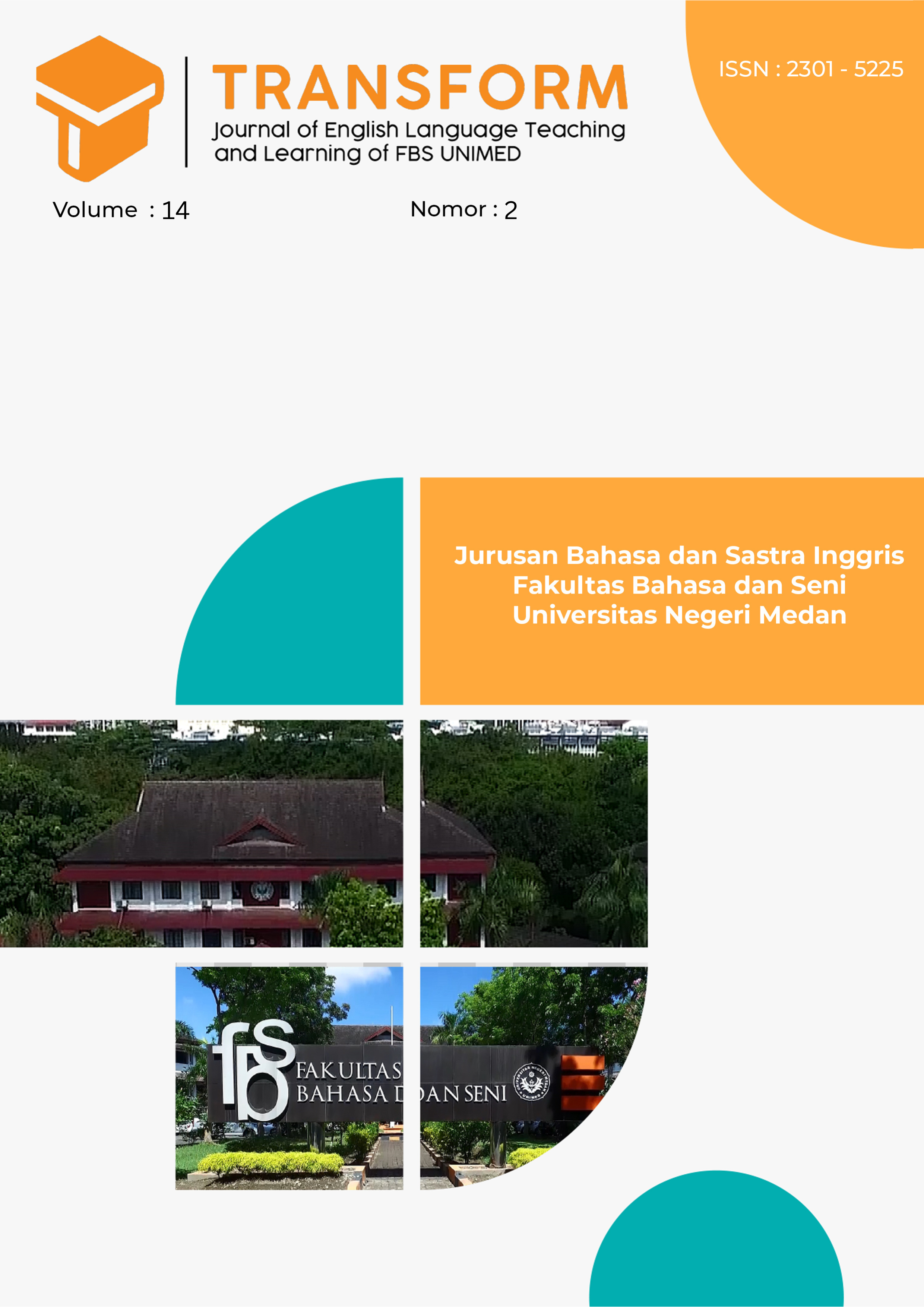Students’ Language Anxiety Levels and Factors in Using ELSA Speak for Grade Eight at SMP Santo Thomas 3 Medan
DOI:
https://doi.org/10.24114/tj.v14i2.67378Keywords:
Language Anxiety, ELSA Speak, Speaking AnxietyAbstract
This study investigates the levels of students’ language anxiety and its contributing factors in using ELSA Speak, an AI-powered mobile application for English speaking practice. Conducted among 26 eighth-grade students at SMP Santo Thomas 3 Medan, the research applied a qualitative method utilizing the Foreign Language Classroom Anxiety Scale (FLCAS) questionnaire and in-depth interviews. The findings revealed that most students experienced mild to relaxed levels of anxiety when using ELSA Speak. Only one student reported an anxious level, while none fell into the very anxious category. Three primary factors contributing to students’ language anxiety were identified: communication apprehension, test anxiety, and fear of negative evaluation. Notably, test anxiety appeared across all anxiety levels, indicating its strong influence in technology-assisted language learning. The study concludes that while ELSA Speak reduces extreme anxiety, the embedded scoring and feedback system remains a source of pressure for learners. Recommendations are made for educators to create supportive learning environments and for application developers to consider the psychological impacts of evaluative features in educational technologies.References
Akriono, F, K., and Isnaini, M. H. (2024). Students’ Perception and Acceptance of “ELSA” to Improve Pronunciation Skill. Journal of English Language and Education 9 (6), 18-27.
Ananda, R. (2023). The Use of “Power Pose” in English Class Interaction in Grade IX of MTSN 2 Medan. Register Journal Unimed 12 (1), 31-37.
Ary, D., Jacobs, L. C., and Sorensen, C. (2010). Introduction to Research in Education. Canada: Wardsworth Cengage Learning.
Duman, I. E., Orhon, F., and Tuncer, A. (2018). The Impact of Mobile-Assisted Language Learning on Students' Language Anxiety and Speaking Skills. Journal of Language and Linguistic Studies, 14(2), 1-15.
Horwitz, Elaine K., Michael B. Horwitz, and Joann Cope. (1986). “Foreign Language Classroom Anxiety.” Modern Language Journal 70 (2): 125–32.
Horwitz, E. K. (2001). Language Anxiety and Achievement. Annual Review of Applied Linguistics, 21, 112-126.
Imelda, M., and Fajardini, J. (2018). Levels of Students’ Anxiety Towards English Teaching Through Songs. Professional Jurnal of English Education, 1(4), 436-441.
Kemendikbudristek. (2022). Kurikulum Merdeka: Capaian Pembelajaran Bahasa Inggris SMP. Jakarta: Kementerian Pendidikan, Kebudayaan, Riset, dan Teknologi.
Kukulska-Hulme, A., and Shield, L. (2008). An Overview of Mobile Assisted Language Learning: From Content Delivery to Supported Collaboration and Interaction. ReCALL, 20(3), 271-289.
MacIntyre, P. D., and Gardner, R. C. (2000). Language anxiety: Its relation to other anxieties and to processing in native and second languages. Language Learning, 41(1), 513-534.
Mayangta, T. (2013) Students’ Speaking Anxiety in an EFL Classroom. Universitas Pendidikan Indonesia Press.
Miguel, P. (2012). The Effects of Anxiety on Cognitive Performance.
Miles, M. B., Huberman, A. M., and Saldana, J. (2014). Qualitative Data Analysis, A Methods Sourcebook, Edition 3. USA: Sage Publications. . Terjemahan Tjetjep Rohindi Rohidi, UI-Press.
Ormrod, J. E. (2021). Educational psychology: Developing learners (8th ed.). Pearson.
Richards, J. C., & Rodgers, T. S. (2014). Approaches and methods in language teaching (3rd ed.). Cambridge University Press.
Rismawati, D., Suryana, Y., Agustiana, V. (2022). The Effectiveness of Elsa Speaking Application in Improving English Pronunciation. The Proceedings of English Language Teaching, Literature, and Translation (ELTLT), 10(1), 177–184.
Sholekhah, M. F., and Fakhrurriana, R. (2023). The use of Elsa Speak as a Mobile-Assisted Language Learning (MALL) towards EFL Students’ Pronunciation. Journal of Education, Language Innovation, Applied Linguistics 2(2), 93-100.
Spielberger, C. D. (2013). Manual for the State-Trait Anxiety Inventory. Consulting Psychologists Press.
Sundayati, H., Surmiyati, S., Bunau, E., & Sumarni, S. (2023). ANALYSIS OF STUDENTS’ SPEAKING ANXIETY IN ENGLISH FOREIGN LANGUAGE (EFL). Journal of English as a Foreign Language Education, 4(1), 42-48.
Wulandari, A., Siregar, M., and Husein, R. (2024), Foreign Language Speaking Anxiety: Speaking Anxiety Levels and Factors among Tenth Grade Students. Jurnal Bahasa dan Sastra, 12(3), 480-491.
Downloads
Published
How to Cite
Issue
Section
License
Copyright (c) 2025 Fransika Saragih, Safrida Lubis

This work is licensed under a Creative Commons Attribution-ShareAlike 4.0 International License.
Authors who publish with this journal agree with the following terms:
- Authors retain copyright and grant the journal right of first publication with the work simultaneously licensed under a Creative Commons Attribution License that allows others to share the work with an acknowledgment of the work's authorship and initial publication in this journal.
- Authors are able to enter into separate, additional contractual arrangements for the non-exclusive distribution of the journal's published version of the work (e.g., post it to an institutional repository or publish it in a book), with an acknowledgment of its initial publication in this journal.
- Authors are permitted and encouraged to post their work online (e.g., in institutional repositories or on their website) prior to and during the submission process, as it can lead to productive exchanges, as well as earlier and greater citation of published work (See The Effect of Open Access).
- This work is licensed under a Creative Commons Attribution-ShareAlike 4.0 International License.








